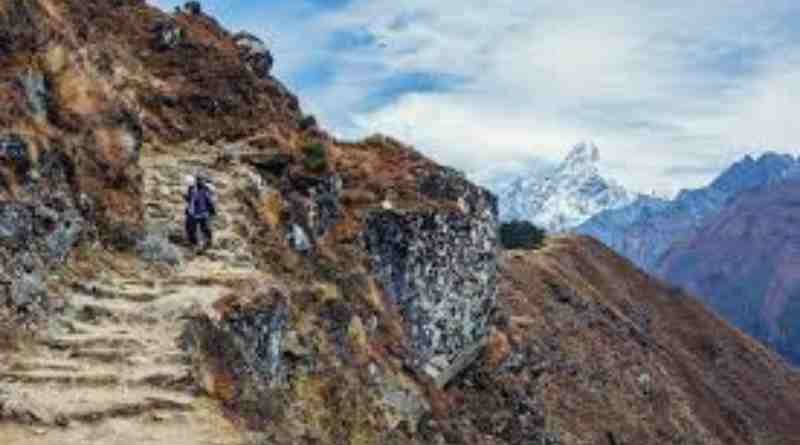Top 14 Frequently Asked Questions About Everest Base Camp Trek
Mount Everest is the highest mountain in the world, rising 8,844.43 meters above sea level. You can appreciate how difficult it must be for tourists to reach the Everest peak or base camp with such recognition. Those who aspire to climb Everest and reach its base camp at 5,364 m (17,598 ft) must get ready for their next journey.
Before embarking on a journey to the summit of Everest or even just any trip in Nepal, one must be well-prepared and knowledgeable about all aspects of the expedition. Travelers can identify questions and answers that can streamline their journey and set them apart from others by conducting in-depth study in advance.
How tough is it to hike to the Everest base camp? is one of the many questions you have during your in-depth investigation that have easy solutions. alternatively what would the cost of hiking to Everest base camp be? Or is the Everest base camp trip better done in the winter? And so forth.
You can look up these kinds of issues online, but you might not find precise, comprehensive answers to your questions. As a result, we are happy to offer you this blog, where you can all find the answers to all of your questions.
This blog section covers all kinds of questions and answers on your ideal Everest base camp trek. Certain queries in this blog may not be frequently asked, and other questions might not be frequently asked among internet forums. We felt compelled to provide detailed responses to the questions and answers listed below because our clients had asked them so frequently.
It’s difficult to answer all of your inquiries concerning Mount Everest and its base camp in a single, concise sentence. Nevertheless, we have made every effort to address both simple and complex queries below.
-
When is the Best Time To trek to Everest Base Camp?
This is without a doubt the most often asked question. The explanation is that opportunities shift with the seasons in the highlands. The best months to hike to Everest Base Camp are March, April, and May during the pre-monsoon season, and September, October, and November during the post-monsoon fall. There is no fog or mist, making it possible to see the mountains in both seasons. It’s important to choose the right season to visit Nepal on your holiday.
The spring and fall are Nepal’s busiest travel seasons. These times can get very congested due to the popularity of the Everest Base Camp (EBC) trip. The trails won’t likely be entirely yours, and getting your first choice of accommodation may be difficult. Hiking with a guide is usually a smart decision, especially in the busiest months when they may assist in securing lodgings that may be challenging to organize on your own.
In addition, even if you do not intend to climb Everest, the region experiences heightened expedition activity throughout the May to early June climbing season. It’s best to book your flights to Lukla well in advance during these busy times since they tend to sell out.
Off Seasons Trekking
at order to avoid crowds and prioritize observing the local flora and fauna, the best time to trek to Everest Base Camp is during the summer/monsoon season (June, July, and August). If you are trekking during this season, exercise caution. There will be plenty of blood-feeding leeches along the walk! Winter in Nepal’s mountains (December, January, and February) can be perfect for you if you love snow and the bitter cold.
Trekking is significantly more difficult in the off-seasons than it is in the other seasons, such as summer/monsoon and winter. There may not be any flights to Lukla due to bad weather and low visibility.
-
How Hard Is Everest Base Camp Trek?
at order to avoid crowds and prioritize observing the local flora and fauna, the best time to trek at Everest Base Camp is during the summer/monsoon season (June, July, and August). If you are trekking during this season, exercise caution. There will be plenty of blood-feeding leeches along the walk! Winter in Nepal’s mountains (December, January, and February) can be perfect for you if you love snow and the bitter cold.
Trekking is significantly more difficult in the off-seasons than it is in the other seasons, such as summer/monsoon and winter. There may not be any flights to Lukla due to bad weather and low visibility.
Trekking to Everest Base Camp (EBC) does not require any technical mountaineering training or experience, while climbing Mount Everest demands years of skill and technique. Because of this, the Everest Base Camp Trek is incredibly accessible to a wide range of people, regardless of skill level.
That much is certain:
the Everest Base Camp Trek is not a stroll in the park and is not recommended for anybody with a “tourist mindset.” Starting at 2,850 meters (9,350 feet) above sea level, your adventure will culminate at the remarkable elevation of 5,632 meters (18,477 feet). There is no denying the physical and mental toll this takes.
If someone claims they had no difficulties completing the Trek, you should assess this information appropriately. If someone tells you the walk was easy, you should take their expertise and level of preparation seriously. However, if someone says that the walk was the most difficult thing they have ever done in their life, we should take into account their preparation, timetable, degree of fitness, lodging, etc. Here are a few things that contribute to the difficulty of the Everest Base Camp Trek.
Duration of the Trek:
The Trek travels 130 kilometers total, which may seem like a long distance at first. When you boil it down, though, you will only be walking nine of the twelve days on a typical guided trek. This implies that you will cover about 15 kilometers a day on average. Given that the average walking speed is approximately five kilometers per hour, the daily trek doesn’t seem all that difficult. It is vital to remember nonetheless that these 15 kilometers will not be on a paved, smooth path. Instead, your progress will be slowed as you navigate through difficult and, occasionally, snowy terrain (depending on the season and altitude).
Altitude:
This trek is more difficult than others of a comparable duration since altitude is its main obstacle. Starting at Lukla, which is at an altitude of about 3,000 meters, and ending at Everest Base Camp, which is at 5,400 meters, there is a significant danger of altitude sickness. At just over 5,500 meters, Kala Pathar, the highest peak, provides amazing vistas. Two acclimatization days are typically included on tours, giving your body time to acclimate to the altitude and take in the surroundings.
Climate and weather:
Because of the unpredictable weather, trekking in the Everest Region can be challenging. Summertime brings a lot of rain, which makes trails slick and decreases visibility. Constant snowfall and respiratory difficulties at high altitudes are characteristics of winter. Low vision poses a risk to flying as well. Hiring knowledgeable guides and gathering information is essential while trekking during off-peak seasons.
-
Is there Wi-Fi on Everest base camp trek routes?
Indeed, there is Wi-Fi available along the paths leading to Everest Base Camp. Along the EBC Trekking trails, there are numerous locations where you may get Wi-Fi. On the other hand, the Everest Link Card service and the Wi-Fi connection at Everest Base Camp are not always dependable. Our experts advise trekkers to think about buying a mobile SIM card for mobile data connectivity if they are determined to have internet access at Everest Base Camp. During the Everest Base Camp Trek, there are several ways to use the internet: Wi-Fi, mobile data, the Everest Link Card, and more. More information about using Wi-Fi while trekking to Everest Base Camp may be found here.
Everest link card
Everest Link Card is a premium wireless broadband internet service designed specifically to meet the communication demands of hikers and keep them in touch with their loved ones. These cards are easily obtained from a number of stores located all around the Everest region.
The Everest Link Card offers more affordable wireless broadband internet when compared to the Wi-Fi available at tea houses during the Everest Base Camp Trek. These cards are available in 50 MB to 100 MB prepaid quantities; the cost of the card varies based on your location and the time of your Trek. These cards are usually available for between US$ 2 and US$ 4.
Wifi
With the exception of the highest point, wifi is accessible all along the route to Everest Base Camp (5,364 meters). Consider purchasing a local Ncell SIM card to stay connected. The primary draws are the breathtaking mountain vistas and landscapes of the area. Internet connectivity is available through Everest Link, however if their server goes down, it affects all of Trek’s wifi. Use this network to share your journey and stay in touch with loved ones.
3G Mobile coverage
2010 saw the launch of mobile service in the Everest region thanks to Ncell, the Nepali division of the massive Swedish telecom company TeliaSonera. With a station in Gorak Shep, a few miles from Mount Everest and situated at 5,200 meters above sea level, Ncell led the way in introducing 3G mobile broadband. During their trek to Everest Base Camp, trekkers can take advantage of Ncell coverage, as there are eight mobile base stations nearby, including one in Lukla.
This table displays the locations along the Everest Base Camp Trek route where internet connectivity is available.
| Landmarks Along the EBC route | Description | WIFI Cost | WIFI Signal | Network Coverage |
| Lukla | Starting point for various Everest Base Camp Treks. Most lodges offer WiFi for $5-6. Starbucks Lukla provides free WiFi | U$D 5-6 (varies) | Good | Ncell and Ntc 3G gsm,
Everest link Wi-Fi prepaid cards (Available but not recommended as it is expensive) |
| Phakding | The first village on Comfort Everest Base Camp Trek. Limited internet in local bakeries. Consider Everest Link Card or mobile network for better connectivity. | Varies | Good | Ncell and Ntc gsm
Everest link wifi prepaid cards ( Available but used only if mobile cell phone network coverage is unreachable) |
| Namche Bazaar | It is the main tourist hub with many lodges offering good WiFi. Free WiFi at Namche Bakery. Tea houses charge $1-2 per hour or use Everest Link Card for faster connection. | U$D 10-15 (unlimited) | Very good | Ncell and Ntc 3G gsm
Everest link Wi-Fi prepaid cards (Available but not recommended to use as phone data works quite well) |
| Tengboche | Limited lodges with weak internet connectivity | U$D 5-6 per hour | Poor | Ncell 3g gsm network coverage (Good and recommended)
Ntc gsm network coverage (Not available) Everest link wifi prepaid cards (Available but used only in case Ncell data is not working) |
| Dingboche | The first village above 4,000m with good internet connectivity in tea houses. | U$D 7-10 per hour | Poor | Ncell and Ntc gsm network coverage (no Coverage)
Everest link Wi-Fi prepaid cards (Available) |
| Lobuche | Higher altitude village with good internet and 3G Ncell Network. Everest Link Card available. | U$D 10 per hour | Very Good | Ncell gsm network coverage (Bad/ no coverage)
Ntc gsm network coverage (Not available) Everest link Wi-Fi prepaid cards: Available |
| Gorakshep | Last human settlement: limited tea houses with WiFi. Everest Link Card or Ncell 3G Network options. | U$D 12 per hour | Very Good | Ncell and Ntc gsm network coverage (Good 2g network for phone calls, moderate data connection)
Everest link Wi-Fi prepaid cards (Available and recommended) |
-
What kind of charging Plug is needed on the Everest base camp trek?
Trekkers heading to Nepal’s Everest Base Camp will typically come across two electricity outlets. There are two or three round prongs on these outlets. Take a charging plug that has two or three spherical prongs as a result. Additionally, some locations could have flat-prong outlets for extension cords and multiplugs. To make sure you can charge your electronic gadgets in Nepal, we advise packing an adapter, converter, and charger kit. In Nepal’s capital city of Kathmandu, electronics stores are often where you may get these things. With the aid of this kit, you can ensure that your gadgets are operational throughout your Trek by connecting them to the appropriate outlets in the area.
When trekking in the Everest Region, numerous tea houses along the Everest Base Camp Trek provide battery charging facilities. All Tea Houses could not, however, have dependable power supplies. Therefore, if solar panels are too expensive to provide the necessary power when needed, think about packing a solar charger or extra batteries. Similar to this, batteries run out faster at higher elevations, therefore it’s imperative that you periodically charge your phones and cameras.
Additionally, use silver foil or other measures to protect your batteries. Power banks and portable power sources are convenient substitutes. Multistage chargers are accessible in certain locations. In places with lower elevations like Lukla, Namche, Tengboche, and Dingboche, you can also pay to charge the battery on your camera. But be prepared for a limited lodge power supply as you rise to Dingboche, Pheriche, Lobuche, and Gokarshep.
-
Is there a chance of getting altitude sickness on the Everest base camp Trek?
During the Everest Base Camp Trek, trekkers typically experience mild altitude sickness in one form or another. But you want to make sure that it doesn’t escalate into something more dangerous.
Even while all of this can seem scary, don’t let it deter you from hiking to Everest Base Camp. Even the most physically healthy hikers, nevertheless, can experience altitude sickness. Because of this, it’s imperative to hike slowly to Mount Everest Base Camp and to make every effort to be ready for high-altitude trekking. Around 3,000 meters (9,840 feet) above sea level is when altitude sickness might strike. Despite the 21% oxygen in the atmosphere at sea level, the number of oxygen molecules each breath decreases as you ascend. The symptoms consist of dyspnea, exhaustion, and nausea.dizziness, headaches, loss of appetite, erratic sleep, and vivid dreams
-
How Much Does It Cost To Trek Everest Base Camp?
The EBC journey is more affordable than you might think and delivers great value.
The cost of the EBc journey for hikers can vary depending on a number of criteria, including the duration of the route, the season, the itinerary, permits, preferences for food and housing, and the degree of support desired. Whether you want to go on a solo trip or decide to join a group, with or without the help of a trekking agency, is another important factor to take into account when estimating the costs of the trek. The average cost of the Everest Base Camp Trek is between $1,000 and $2,000 per person. On the other hand, you may go on a 12-day Everest Base Camp Trek for as little as $1,400 if you book through our services. Here is additional information regarding The Everest Base Camp Trek cost. Additionally, we offer group prices as follows:
For 1 to 4 participants: $1,300 each
For 5 to 10 participants: $1,200 each
For 11 to 20 participants: $1,175 each
Here is the cost Breakdown for the Everest Base Camp Trek in the Table:
| Cost Category | Estimated Cost (USD |
| Visas
– Multiple entry 15 days – Multiple entry 30 days – Multiple entry 90 days |
$25
$40 $100
|
| Insurance
– Travel Insurance – Emergency medical coverage |
Variable
Varies from ($100-$1000 or more) Varies from ($100-$1000 or more)
|
| Equipment and Gear
– Gear purchase – Gear rental (optional) |
$400 – $500
$2 – $5 per item |
| Hiring a Porter
|
Daily wages: NPR 2,000 (includes
accommodation and food) Insurance: NPR 3,000 Tips: 15% of wages or higher |
| Hiring a Local Guide | Daily wages: NPR 2,500 (includes
accommodation and food) Insurance: NPR 3,000 Tips: 15% of wages or higher |
| Flight to Lukla and back | $358 (approximate) |
| Personal expenses | $400 – $600 (approx.) |
| Accommodation (Basic Rooms)
|
$30-%0 on average per person
Note: Rooms are mostly on a twin-sharing basis. Basic room costs are as follows: Npr 500 in Lukla, Phakding, Monjo, Tengboche, Deboche, Pangboche, Dingboche and Pheriche. Npr 700 in Lobuche and Gorakshep Npr 1000 in Namche Bazaar The attached Rooms cost NPR 1000 and higher. |
| Hot Shower | Total $40- $70 per person |
| Battery Charging | around NRP 150 – 500
Per hour for mobile charging |
| Everest Link Wifi Cards | NPR 600 – NPR 2,000
600 MB Wifi card: NPR 600 |
-
How Many Days To Get To Everest Base Camp?
It usually takes 12 to 24 days to reach Everest Base Camp. The journey from Lukla to Everest Base Camp takes about eight days to complete, covering a total of about 140 km. The travel back to Lukla takes an additional four days. Trekkers often allow one to three days for acclimatization before leaving on an excursion. The Trek’s length can vary greatly depending on whether it is finished entirely on foot from Jiri or Phaplu, by regular aircraft to Lukla, or by helicopter to Everest Base Camp.
Trek to Everest Base Camp Via Lukla With Lukla Flight
With a shorter 12-day trek, the Lukla route to Everest Base Camp is more convenient and speedier. The first part of your itinerary is a quick scenic flight from Kathmandu to Lukla, after which you’ll climb to Phakding that same day. After a quick flight from Lukla to Kathmandu, the 130-kilometer round-trip journey takes 12 days. The world’s highest base camp may be reached quickly and profitably with this trek that takes you via Lukla.
Trek to Everest Base Camp Via Phaplu/Jiri
Trekking Jiri or Phaplu offers a traditional and less-trod path to the famous Everest Base Camp. It takes roughly 24 days to hike from Jiri to Everest Base Camp and then take a plane back to Kathmandu. Choosing to walk from Phaplu to EBC instead of taking a flight back to Lukla takes about 16 days. A distinct and less crowded view of the magnificent Everest region is offered by both paths.
-
What Kind Of Food Do We Get On The Trail To Everest?
The Everest Base Camp Trek in Nepal is drawing hikers from all over the world and is growing in popularity. These days, the trail is lined with many tea cafes that provide a variety of dishes. Luckily, there are many of tea houses strewn along the pathways that conveniently serve lunch for those starting the Everest Base Camp Trek and its various routes. Hikers can recover and have a hot dinner at these quaint accommodations each evening. Toast, eggs, potatoes, and tea or coffee are typical breakfast fare.
Menu items often include noodles, sherpa stew, and dumplings, but traditional Dal Bhat is the highlight (see our recipe for Traditional Dal Bhat). Lentil soup, rice, spinach, seasonal vegetables, and Aachar (pickle) are all part of this filling lunch. Essential carbohydrates are provided by Nepali Dal Bhat, which is needed to trek for six to seven hours a day for a duration of fourteen to fifteen days. There is also a proverb in Nepal that reads, “DAL BHAT POWER, 24 HOURS.”
-
What Kind of Equipment Do I Need For The Trek To Everest Base Camp?
Put the Everest Base Camp Trek Packing List first as you go from Lukla, which is located 28,60 meters above sea level, to Kala Patthar, which is located 5,644 meters above sea level. You will go via Namche Bazaar, Dingboche, Lobuche, Gorakshep, and Kala Patthar starting on the first day, all of which are difficult terrains. Having a well-planned Everest Base Camp Trek Packing List that includes all essential goods is crucial, especially considering the challenging terrain of these areas. This is a thorough packing list for your trek to Everest Base Camp. Please refer to the “Also check our Packing List for trekking in Nepal” for complete information on what to carry in terms of clothes, gear, and necessities for trekking in Nepal. This source offers further information about organizing your trip to Nepal.
-
Is Drinking Water Available During The Trek and Is It Safe?
Of course, there is fresh water available for drinking on the Everest Base Camp hike, so you can stay hydrated and safe. There are many of easily accessible, dependable water sources all along the trekking course. These are several options for getting clean drinking water when trekking.
Use a stream or the tap.
You can come across streams or taps on the trail. Despite their apparent cleanliness, they might contain dangerous pollutants. To guarantee safe consumption, use UV purifiers, filters, or tablets for water purification. These solutions eradicate germs, viruses, and protozoa; nevertheless, note the taste sensitivity or battery requirements of UV purifiers. When going on outdoor adventures, remember to keep safe and hydrated.
Water in Bottles
Most of the hotels and tea shops along the walking path sell bottled water. However, this decision can be expensive, especially as you go higher up, and it also contributes to the local plastic pollution. Investigate more environmentally friendly options.
boiled liquid
The majority of lodges and teahouses provide reasonably priced boiling water, which effectively eliminates dangerous bacteria and guarantees safe drinking. At least one minute (three minutes at higher elevations) should be spent boiling water. Drink three to four liters of water each day to stay hydrated. Minimize your use of bottled water by using environmentally friendly water treatment methods. Put clean water first in order to avoid disease. See How Was Drinking Water in the Nepalese Himalayas for more specific details.
-
Can The Domestic Flight To Lukla Get Delayed Or Canceled?
It is possible for domestic flights to Lukla to be canceled or delayed. There are many difficulties for flight operations at Lukla Airport. Its twisty, little valley leads to the runway, which is situated at the brink of a cliff. Only tiny aircraft and helicopters are able to use this tiny airfield as a result. Furthermore, because of its distinct topography and high height, Lukla experiences quick changes in visibility and weather.
Although delays happen frequently all year round, they are more likely to occur in the monsoon season (late May to early September). Airlines may decide to return planes to Kathmandu rather than take the chance of an unsafe landing in changing weather circumstances since safety comes first. There can be a few hours to many days in between these delays.
If your flight is canceled, most airlines will reschedule you for the next available flight. In the event of protracted cancellations, you can begin your Trek by driving to Jiri or Salleri. or We’re going to divert your flight to Manthali Ramechaap.
-
What Is Acute Mountain Sickness (AMS) and How Likely Am I To Get AMS?
attacks hikers who ascend into higher altitude regions. In a similar vein, AMS can also happen if hikers climb or trek too quickly. The barometric or atmospheric pressure is the air pressure in which you now reside. As hikers ascend beyond Namche Bazaar on their Everest Base Camp journey, the air pressure decreases, resulting in a reduction of oxygen availability in the surrounding environment. Furthermore, if you frequently travel to these high-altitude locations or reside in high-altitude regions like Sherpas, you become accustomed to the low air pressure.
However, if you live in a lower altitude, it will take some time for your body to acclimate to the difference in air pressure when you travel to higher altitudes. Above 8,000 feet, trekkers are usually more vulnerable. Trekkers who are prone to altitude sickness often experience headaches, nausea, dizziness, exhaustion and low energy, dyspnea, vomiting, difficulty sleeping, and appetite loss. Usually, 12 to 24 hours after ascending higher, these symptoms appear. After a day or two, it gradually decreases as your body adjusts to the altitude adjustment.
If you have a lesser case of altitude sickness, you could realize that over-the-counter medications don’t help and your symptoms get worse. You may experience worsening dyspnea and increased exhaustion. You may also experience symptoms including constriction in your chest, a strong headache that doesn’t go away with medicine, and impaired coordination and difficulties walking. If your altitude sickness gets worse, the typical type of AMS becomes High Altitude Cerebral Edema (HACE) or Pulmonary Edema (HAPE), where you can get symptoms including confusion, difficulty breathing even when at rest, difficulty walking, and more. A state of unconsciousness and a frothy white or pink discharge are the results of a chronic cough.
-
What is an alternative way if a Lukla flight is Cancelled?
Everest trekkers are well aware of the regular and unforeseen cancellations of flights to Lukla. The weather in the Himalayan region is notoriously unpredictable, which contributes to the instability of the flights between Lukla and Kathmandu. Most Lukla flight cancellations occur from early October through the start of the monsoon season. The three most popular options in the event of a Lukla flight cancellation are: divert flights from Ramechhap (Manthali) to Lukla; take a helicopter trip from Kathmandu to Lukla; or arrive in Lukla by land (Jiri or Phpalu).
Ramechhap (Manthali) to Lukla Flight-
You can board a diverted flight from Ramechaap to Lukla in the event that your flights from Kathmandu to Lukla are canceled. Rather than taking the 35-minute flight from Kathmandu to Lukla, Ramechhap offers a shorter 12-minute journey. This implies more chances for faster aircraft turnarounds when the weather is suitable. Due to flight priority, delays may still happen in Kathmandu even in the case of favorable weather in Lukla. Alternatively, there is a 20-minute flight to Lukla from Manthali Airport, which is around 4 hours away from Kathmandu. It’s easier to plan a flight from Manthali Airport to Lukla, even in inclement weather.
Lukla Helicopter Flight-
Helicopter travel to Lukla is a dependable substitute for flying during aircraft delays in the Everest region. Trekkers use Lukla as a major entry point, particularly during the busiest travel seasons. If you have a flexible budget and limited time, scheduling a helicopter service from Kathmandu to Lukla is an excellent way to guarantee a reliable trip to Lukla.
Reach Lukla via land (Jiri or Phpalu)
An even more excellent option to the Lukla flight is to travel by land to Jiri or Phaplu (Tham Danda), which are lengthier routes that lead to the Everest region. Jiri is the starting point of the 8-hour road ride from Kathmandu to Everest Base Camp. This road trip, which is 190 kilometers long, usually takes nine or ten hours. The actual Trek begins in Jiri and takes approximately 7 to 8 days to complete from Jiri to Lukla.
Taking a jeep ride up to Tham Danda is the first step in the alternate route from Phaplu (Tham Danda) to Lukla. through Phaplu. You spend the night in the village and then walk to Lukla. You spend the next two days trekking from Tham danda to Lukla.
-
What is an emergency option if I feel sick or break my leg?
The greatest emergency plan is to hire a helicopter if you are ill with a medical condition (such as AMs) or if you break your leg and are unable to finish the hike. Make sure you have comprehensive travel insurance that covers emergency rescue and evacuation, as well as the option for helicopter evacuation if necessary, before you set out on your adventure. Read your insurance policy’s terms and conditions carefully to learn about the scope of coverage, the upper and lower bounds of your height, and the activities that are covered.
The best course of action in this situation is to reserve helicopter services for your EBC journey if you do not have insurance that will cover emergencies. We typically provide two different helicopter services—Private Helicopter Service and Group Joining Helicopter Service—at a reasonable cost in case of an emergency. Access to emergency helicopter evacuation and medical help is guaranteed by travel insurance. However, in the event that they require medical attention and return transportation to Kathmandu, individuals without insurance have few options. As a result, you can book a helicopter service at any time throughout the Everest Base Camp Trek. More information on the Everest Base Camp Trek without Insurance may be found here.
Read also: check




